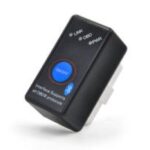OBDII (On-Board Diagnostics II) trouble codes are your car’s way of talking to you. These alphanumeric codes signal potential problems within your vehicle’s systems. Understanding these codes empowers car owners and mechanics to diagnose and address issues effectively. This guide serves as your handy OBDII pocket trouble code reference.
OBDII systems use standardized codes, making diagnostics more universal. However, some codes remain manufacturer-specific. A quality OBDII scanner provides access to a broader range of codes, enabling more comprehensive diagnostics.
Decoding the OBDII System
Mandated in the US for vehicles manufactured after 1996, the OBDII system monitors emission-related components and overall vehicle performance. The system’s brain, the Electronic Control Unit (ECU), continuously analyzes data from various sensors. When a problem is detected, the ECU generates a Diagnostic Trouble Code (DTC), pinpointing the issue’s nature and location. This information is crucial for efficient troubleshooting.
Accessing OBDII Trouble Codes
Retrieving OBDII codes is a simple process:
-
Locate the OBDII Port: Typically situated beneath the dashboard on the driver’s side, this standardized port may sometimes reside under the hood.
-
Connect an OBDII Scanner: Plug a compatible scanner into the port. These scanners are readily available.
-
Retrieve the Codes: The scanner communicates with the ECU, displaying stored DTCs.
Deciphering OBDII Trouble Codes
OBDII codes follow a specific structure:
-
First Character (P, B, C, U): Indicates the system (Powertrain, Body, Chassis, Network).
-
Second Character (0-9): Specifies the fault type within the system. ‘0’ often denotes a generic code applicable across manufacturers.
-
Third and Fourth Characters (0-9): Further define the fault’s location or nature.
-
Fifth Character (0-9): Indicates severity, ranging from minor to critical.
Common OBDII Trouble Code Categories
-
P Codes (Powertrain): Related to engine, transmission, and emission systems. Examples include:
- P0300: Random/Multiple Cylinder Misfire Detected
- P0420: Catalyst System Efficiency Below Threshold
-
C Codes (Chassis): Pertain to non-engine components like steering, brakes, and suspension:
- C0035: Left Rear Wheel Speed Sensor Circuit Malfunction
- C1214: Brake Control Relay Contact Circuit Open
-
B Codes (Body): Cover issues with interior and exterior components, such as:
- B0020: Front Passenger Side Deployment Loop Resistance High
- B1000: Electronic Frontal Sensor Data Problem
-
U Codes (Network): Indicate communication problems between vehicle systems:
- U0073: Control Module Communication Bus A Off
- U0140: Lost Communication with Body Control Module
Effective OBDII Troubleshooting
While OBDII codes provide a starting point, effective diagnostics require further investigation:
-
Consult Resources: Utilize your vehicle’s repair manual or online databases like ALLDATA for detailed code definitions and troubleshooting guides.
-
Professional Assistance: For complex issues, consult a qualified mechanic equipped with advanced diagnostic tools.
-
Preventative Maintenance: Adhere to your vehicle’s recommended maintenance schedule to minimize potential problems.
-
Check for Recalls: Investigate potential manufacturer recalls or warranties related to identified issues.
Conclusion
This OBDII pocket trouble code reference provides a foundational understanding of how to interpret these essential diagnostic clues. Remember, OBDII codes are a starting point. Thorough diagnostics may require further research and professional expertise. Using this guide along with other resources will assist you in keeping your vehicle running smoothly.

